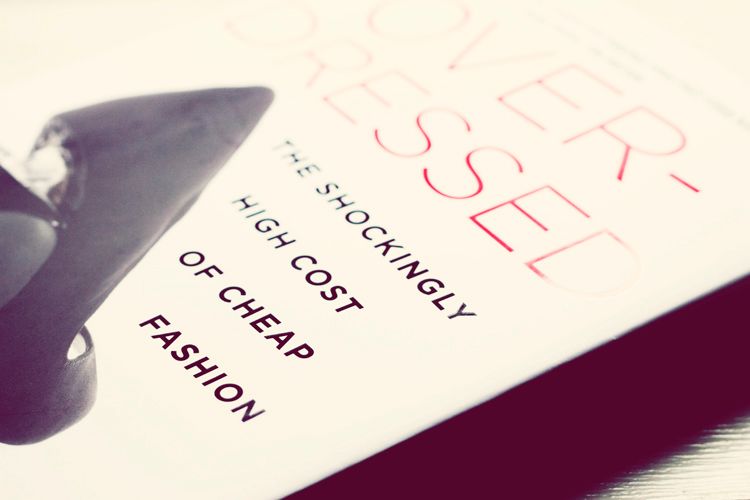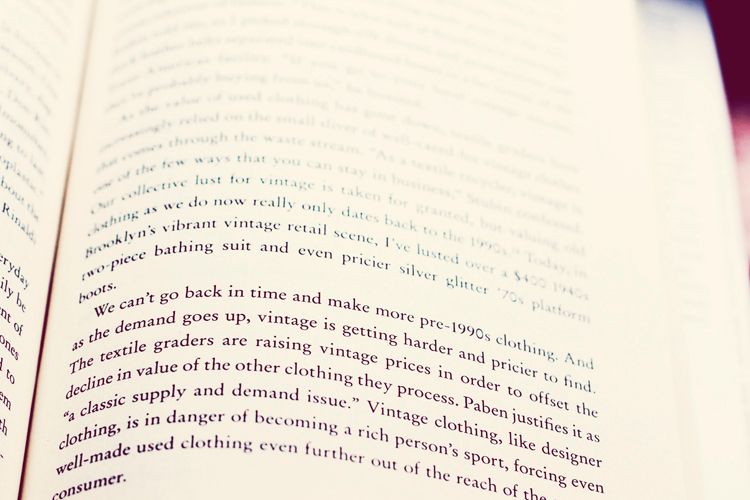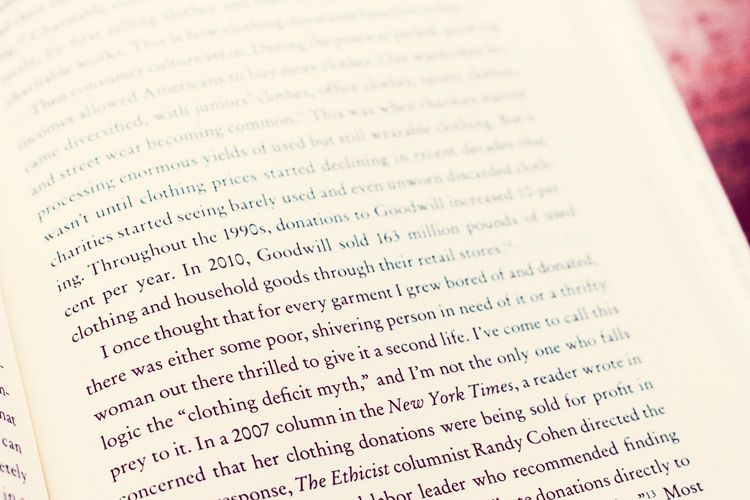Review: Overdressed, The Shockingly High Cost of Cheap Fashion.

Most recently that thing we all do wrong is food. Eat all your vegetables?
Yes? Good.
Are they organic locally grown non genetically modified vegetables that sprout from soil from the Hanging Gardens of Babylon and watered with kitten tears?
No?
You may as well give up.
Being somewhat of an outsider in the world of modern fashion I see its endless issues in much the same way. What's the point of trying? Not support companies who manufacture products in "sweatshops"? I guess.
We all know sweatshops are bad. Thank you college graduates of the 90s. We get it. But it's not as simple as that.
I was offered up Overdressed, The Shockingly High Cost of Cheap Fashion By Elizabeth Cline to review. I find the subject of mainstream fashion today incredibly intriguing, not on the surface, but underneath it all.

I didn't really expect this book to unleash any new information other than the basics of what we are all aware of, which is sweatshops are still bad, and if you don't buy anything made overseas, you're good.
In reality what we think of as a simple good/bad situation is a tangled and complicated web, one that seems so overwhelming that in the midst of the book you might just decide to go live out in the woods on leaves and berries and weave your own fabric from your dogs hair just to offset the results of the damage your consumerism has done.
It's ok. Breath. Finish the book.
I know many of you, like me, live a more vintage centered life than a modern one, and that part of me found some particular sections of the book especially interesting. Like accounts of what has become of labels of the vintage garments hanging in my closet. For instance Bobbie Brooks, a popular juniors line in the 1950s has morphed into a Dollar General brand.

One thing that really stood out to me is that merchandise in stores moves so fast, our only choice is to impulse buy. In previous 20th century eras stores rotated merchandise seasonally, four times a year. If you were building your wardrobe with a tight budget, you could scrimp and save for something you saw at the department store. It would still be there when you'd saved enough, and you would value it. You would have thought over your decision, made sacrifices, and made sure the garment was worth the money (quality not brand). Because of these factors you would care for that garment. Mend it. Properly clean it. Store it well. And in return you could pass that item onto your grandchild in much the same condition as when you wore it.
That won't happen with my generation.
You see something at a store such as Forever 21 and buy it right away. It's cheap, it's on trend, and chances are it won't be there next week.
Even if you have the attitude of only buying locally or domestically made products of quality, your choices are limited. It's hard to do. Especially if you're buying womens wear. Recently Sam and I were in a shoe store in Portland that's been known for carrying a selection of mid-level quality footwear. I went over to the mens section and turned over the shoes. Not to look at the price, but to look at the label. Some were made in the U.S. some were not. Most of them were heavy, made of nice leather and thick soles, with stitching and a classic look that would last through trends. Then I went over to the womens section.
Sam had to usher a scowling and ranting Solanah out of the store.
I picked up a trendy looking leopard print wedge and nearly flung it up in the air it was so light compared to the heavy, durable mens shoes. Then I looked at a womens oxford that would be fair to compare to the mens oxford. It was also light, and the sole seemed to be made of some sort of foam rubber hybrid. I love my vintage oxfords, but in no way treat them like glass slippers. I wear them without caution, and if I were to wear the oxfords in the store the same way I wear my vintage ones, they'd be dead in a month.
I could go on. And I might in the future, but when it comes right down to it, I really think you should read this book. It's good, it's eye opening, and while I won't say something cliche like "it will change your life", I will say it might change the way you look at shopping and your own wardrobe. There is a solution, as stuck as we may seem, and unsurprisingly that solution takes a nod from how our mothers and grandmothers viewed clothing.
So read the book.
I'm going to go attack my massive mending pile and teach my cousins to sew their own clothes.
{Overdressed, The Shockingly High Cost of Cheap Fashion}







31 comments:
Hi Solannah,
I have read this book,and since have not physically been able to purchase 'fast fashion' clothing. My vintage shopping habbits have always been different to many of my friends but this book really challenged and changed the way I shop...
Thanks for your comments,
Rebeccajoy xx
This sounds like a really intersting book and your review has certainly given me something to think about. Though it is obvious now you've pointed it out, the speed of fashion these days is something I've never really noticed but it is frightening. I think my biggest concern is that vintage is moving in a similar direction, because it must be purchased online and I have the constant feeling that it's "now or never". The stock is dropping adn prices increasing... It's a scary thought. hmm... x
This book sounds good! It is an issue I have been interested in for a while & honestly can't remember the last time I purchased something from a retail store. I just can't justify paying $30 for an item I know cost about $5 to make! Markets are my go to 'store' these days ... Will have to see if I can find this book in Australia.
Kel x
Great review! I added this book to my Amazon wishlist yesterday after seeing it mentioned on the Etsy blog. It sounds very interesting and might give me the motivation I need when it comes to garment sewing (I have a love-hate relationship with it :).
~Kristin
I want to scream now because I recently purchased a Bobbie Brown pink vest-shirt! Hurray :)
Bobbie Brooks, sorry!
I think its so sad how we live in such a disposable society. Clothes these days are a ripoff.....poorly made, poor materials, and you're lucky to get a year out of them before they start to look ragged. That's why I want to learn how to sew. At least then they will last longer. :)
what a great and interesting post! that book is intriguing! thanks for sharing!
This is the reason I took up sewing. I love vintage but its getting harder to come by! Especially down here in Aus.
That said, there's got to be ethical considerations when it comes to sewing your own clothes too. You're right in asking where does it stop?
We all have to draw a line somewhere - but I think people should be fully aware of the choices they're making.
I wish the value would be brought back into clothing. Even buying "luxury" items doesn't guarantee you quality these days.
Kitty, exactly, it seems the problems never end. Even when making your own clothing you can take into consideration where the fabric and notions come from. It doesn't stop! But it's a step in the right direction. And it cuts out so many unethical factors.
xoxo
Solanah
Great post - I like your humerous yet serious tone :)
I've actually just bought the book now, can't wait for it to arrive!
On the rare occasions when I go to the mall, I'm shocked by the terrible quality and fit of the clothes. My town just got an Old Navy, so I walked in just to check it out and ended up trying on a vintage-style gingham dress that looked cute from a distance. It had THE crookedest construction I had ever seen and the fabric felt like tissue paper. Yuck! Their target consumer would probably wear the dress once and toss it away.
Trends for Women's wear is increase day by day
Thank you for a great review, the book has now been added to my must-read list =)
This is one of the many reasons why I sew, although as Kitty said, there are ethical dilemmas with that as well. However, another way out of this that I scarcly hear mentioned is paying someone to sew for you. Yes, it will cost more but you'll get a unique garment that fits you, will last and probably be a lot easier to alter and mend when need be. I know most seamstresses sew special occasion wear but isn't that 'cause of demand? I myself harbour (distant) dreams of sewing everyday wear on comission.
The problem may be that most people are willing to pay 1000$ for a dress they wear once, but not 200$ for a skirt they could and would wear once a week for the next 20 years.
Maybe times are changing, as more become aware of the problems with fast fashion, and I do hope the traditonal trade of the dressmakers is re-born as a consequence.
Hi Solanah, thanks for the review. I love reading these types of books so I definitely will be reading this one.
I'm with you on the shoe rage. I like to do a lot of walking on my work breaks but the soles of my shoes wear down SO FAST (like, over the course of a few wears). It drives me insane, especially as my boyfriend has been wearing the same pair of shoes for over a year and they are fine.
I really liked your review! I used to work for a fast fashion chain where we had to frequently go to workshops and classes in other cities to learn about the production of our clothing (among other things). We prided ourselves on not using child labor and paying a livable wage even though a lot of our manufacturing took place in countries like China, India, Honduras, etc.
It is extremely hard to do that in an impoverished country. The factory owners, managers and even workers will lie to you about the conditions. The owners and managers because they want your business and the workers because they are intimidated into lying. People from the company would inspect the factories and find out later that they lied about their pay rate, breaks, days off, wage, and everything in between. Now they have started shifting a lot of production to places like Germany where it can be easily monitored and they have workers rights.
The worrying thing is people would chew the sales associates out saying things like, "You can only sell things so cheaply because you use child and slave labor!" They would say this while checking out at the cash register never thinking about how it reflects on them...
I've seen a few reviews of this book floating around the blogs lately & I've been dying to pick it up myself for a read. The whole "fast fashion" concept is really fascinating to me - in a trainwreck sort of way (I can't look awaaaay!). As a seamstress & a wearer of vintage, I agree with your points & tend to find myself cringing when I walk through the shoe department too haa - and don't get me started on the cheap/flimsy heels that are so popular... so tall, with barely any real support or engineering, it makes me die a little to imagine what they are doing to the wearer's feet and back.
It's hard to get the majority of the population to even value a well-made garment anymore. Not only are our clothes so cheap & easy to throw away - but the fads are changing so FAST now. It's crazy when you compare how long fashions stuck around even 20 years ago.
great post! I can totally see you having a mini-freakout in the shoe store. I would too!
Thanks for pointing this book out to me. I have heard that the states is lucky to still be producing a reasonable amount of clothing themselves, compared to everywhere else. I find it scarey that whole countries are losing the skill to make clothing (and other things)which at the very basic level, is a necessity.
This is a subject dear to my heart. I'm in my mid 50s and I remember when we could only buy Bobbie Brooks at a fancy little dress shop called Three Sisters and White Stag was a la-ti-da label offered at ski shops. Just about fainted when I first spotted these labels at Wal-Mart! I remember when clothes shopping was a special event that we only undertook after carefully examining our closet to figure out what holes needed to be filled. It's hard to believe in these days where we wheel around a shopping cart and throw cheap t-shirts into it indiscriminately at the local big box store!
THIS. THIS. THIS. THIS.
I have been saying this for years. thank you so SO much for sharing it on your blog.
<3 <3 <3
So know what you mean! I have 2 pairs of Oxford shoes so I can give one pair a break so they will last longer. I haven't had the two pairs for more than a year and they are looking way worse for wear.
What a fantastic post!! I am definitely going to get my hands on that book. I couldn't agree more with what you are saying. I think an important thing we all need to remember is that the responsibility (and power) lies with us, the consumer. They are only able to keep mass producing these terrible quality items as long as we continue to buy them. The best thing we can do is not support them, and demand ethically made, quality items.
Thank you for the review! It's a subject I have been thinking about, but I didn't know about this book until now!
Thanks for the review, Solanah! I put this book on hold at my library a few days before you posted about it, and now I can't wait to read it! Funnily enough, I stopped by H&M and Forever 21 the other day in search of some cheap sunglasses, and it really just struck me how disgusting the amount of soley fashion waste we generate as a society. Not to mention how shabbily made things are and don't hold up at all to wear. I still remember back in the 90s buying shoes that were meant to last for as long as I could wear them, and then were passed down to my sister. Couldn't do that now. And yet, in order to clothe yourself you have to participate in the modern fashion industry at some level and support it. It's a tough nut to crack. I'd love to be able to buy more solidly constructed items for the things I don't thrift or make (shoes being one!). I actually find "fast fashion" is more expensive in the long run than the investment pieces! I'd much rather have fewer, quality pieces than a lot of crap.
Excellent review and selection of points that you raised. I too have thought often before about how one rarely has the luxury any more of trying to save up for a garment that we hope to buy. On more than one occasion, I've seen something in (modern) shop that I liked (that had several in stock at the time), but didn't want to rush into buying (I don't like to shop impulsively usually), returned a mere day later and it was gone (in my size), with no hope of any more coming in. This doesn't happen every day of course, but it can certainly be frustrating when it does. I like to feel like I'm in control of when and what I buy, not the other way around!
♥ Jessica
Sounds like a very interesting read!
When I lived in Hong Kong for 3 months the consumerism I saw there blew me away. No, not everybody is like that but the amount of people I would see lining up outside H&M (not even for one of their collection launch days) before it was open amazed me. I went in a couple of times out of interest but always end up wondering what it is people actually buy in stores like that. I am a vintage lover so I guess it's not realy my thing! ;)
You can see the evidence on the high turn over in fashion in op shops. These days you really have to dig through the crappy cheap clothing to find the good stuff.
This book sounds absolutely fascinating! Can't wait to read it!
♥Sarah♥
theantiquepearl.blogspot.com
Officially on my Goodreads "To-Read" list.
Thanks for the review! I'd be really interested in checking out a copy of this book. Earlier in the year I read a book called To Die For: Is Fashion Wearing Out The World by Lucy Siegel. It was in a similar vein to this book, and it made me re-evaluate my shopping habits.
Post a Comment